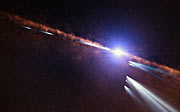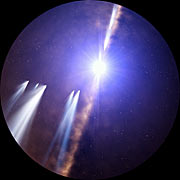Komunikat prasowy
Znaleziono dwie rodziny komet wokół pobliskiej gwiazdy
Największy przegląd egzokomet wokół Beta Pictoris
22 października 2014
Instrument HARPS w Obserwatorium La Silla posłużył do wykonania najbardziej kompletnego jak dotąd przeglądu komet wokół innej gwiazdy. Francuski zespół astronomów zbadał prawie 500 indywidualnych komet okrążających gwiazdę Beta Pictoris i odkrył, że należą do dwóch osobnych rodzi egzokomet: starych egzokomet, które prawdopodobnie dokonały już wielu zbliżeń do gwiazdy, oraz młodszych egzokomet, które prawdopodobnie pochodzą z niedawnego rozbicia jednego lub więcej obiektów. Nowe wyniki ukażą się 23 października 2014 r. w czasopiśmie „Nature”.
Beta Pictoris jest młodą gwiazdą, oddaloną o 63 lat świetlne od Słońca. Ma zaledwie 20 milionów lat i otacza ją olbrzymi dysk materii – bardzo młody i aktywny system planetarny, w którym przez parowanie komet i zderzenia planetoid tworzony jest pył i gaz.
Flavien Kiefer (IAP/CNRS/UPMC), główny autor nowych badań, wyjaśnia wstępnie: „Beta Pictoris jest bardzo ciekawym obiektem! Szczegółowe obserwacji egzokomet dają nam wskazówki pomagające w zrozumieniu jakie procesy zachodzą w tego rodzaju młodych systemach planetarnych.”
Od około 30 lat astronomowie obserwowali subtelne zmiany światła Beta Pictoris, które – jak uważano – mogły być spowodowane przechodzeniem komet przed gwiazda. Komety są małymi ciałami o rozmiarach kilku kilometrów, ale zawierają duża lodów, które sublimują, gdy kometa zbliża się do gwiazdy, tworząc długi warkocz gazu i pyłu absorbujący część przechodzącego przez niego światła. Słabe światło egzokomety jest przyćmione przez oślepiające światło gwiazdy, nie można go więc sfotografować z Ziemi bezpośrednio.
Aby zbadać egzokomety w układzie Beta Pictoris, zespół przeanalizował ponad 1000 obserwacji od 2003 do 2011 roku, dokonanych za pomocą instrumentu HARPS na 3,6-metrowych teleskopie ESO w Obserwatorium La Silla w Chile.
Badacze wybrali grupę 493 różnych egzokomet. Część egzokomet była obserwowana po kilka razy i w ciągu paru godzin. Staranne analizy dostarczyły pomiarów prędkości i rozmiarów obłoków gazu. Wydedukowano także niektóre z orbitalnych parametrów każdej z egzokomet, takie jak kształt i orientacja orbity oraz odległość od gwiazdy.
Analiza kilkuset egzokomet w jednym układzie pozasłonecznym jest unikalna. Ujawniła istnienie dwóch osobnych rodzin egzokomet: pierwsza to stare egzokomety, których orbity są kontrolowane przez masywne planety [1], a druga prawdopodobnie pochodzi od niedawnego rozpadu jednego lub kilku większych obiektów. Różne rodziny komet istnieją także w Układzie Słonecznym.
Egzokomety pierwszego rodzaju mają różnorodne orbity i wykazują raczej słabą aktywność, z małym tempem produkcji gazu i pyłu. Sugeruje to, że obiekty te wyczerpały swoje zasoby lodu podczas wielokrotnych przejść blisko Beta Pictoris [2].
Egzokomety z drugiej rodziny są znacznie bardziej aktywne i mają prawie takie same orbity [3]. To z kolei sugeruje, że członkinie tej rodziny mają takie samo pochodzenie: prawdopodobnie powstały w wyniku rozpadu większego obiektu, którego fragmenty znajdują się na orbitach zbliżających się do Beta Pictoris.
Flavien Kiefer podsumowuje: „Po raz pierwszy badania statystyczne ustaliły fizykę i orbity dla dużej liczby egzokomet. Praca daje istotny wgląd w mechanizmy działające w Układzie Słonecznym tuż po jego uformowanie się 4,5 miliarda lat temu.”
Uwagi
[1] Odkryto także wielką planetę Beta Pictoris b, na orbicie w odległości około miliarda kilometrów od gwiazdy. Obiekt zbadano dzięki zdjęciom w wysokiej rozdzielczości uzyskanym techniką optyki adaptatywnej.
[2] Co więcej, orbity komet (mimośród i orientacja) są dokładnie takie, jak przewidziane dla komet uwięzionych w rezonansie orbitalnym masywnej planety. Własności komet pierwszej rodziny wskazują, że planeta w rezonansie musi znajdować się około 700 milionów kilometrów od gwiazdy – bliżej niż odkryta planeta Beta Pictoris b.
[3] Czyni je to podobnymi do komet z rodziny Kreutza w Układzie Słonecznym, albo do fragmentów komety Shoemaker-Levy 9, które uderzyły w Jowisza w lipcu 1994 roku.
Więcej informacji
Wyniki badań zaprezentowano w artykule pt. "Two families of exocomets in the Beta Pictoris system", który ukaże się 23 października 2014 r. w czasopiśmie Nature.
Skład zespołu badawczego: F. Kiefer (Institut d’astrophysique de Paris [IAP], CNRS, Université Pierre & Marie Curie-Paris 6, Paryż, Francja), A. Lecavelier des Etangs (IAP), J. Boissier (Institut de radioastronomie millimétrique, Saint Martin d’Hères, Francja), A. Vidal-Madjar (IAP), H. Beust (Institut de planétologie et d'astrophysique de Grenoble [IPAG], CNRS, Université Joseph Fourier-Grenoble 1, Grenoble, Francja), A.-M. Lagrange (IPAG), G. Hébrard (IAP) oraz R. Ferlet (IAP).
ESO jest wiodącą międzyrządową organizacją astronomiczną w Europie i najbardziej produktywnym obserwatorium astronomicznym na świecie. Jest wspierane przez 15 krajów: Austria, Belgia, Brazylia, Czechy, Dania, Finlandia, Francja, Hiszpania, Holandia, Niemcy, Portugalia, Szwajcaria, Szwecja, Wielka Brytania oraz Włochy. ESO prowadzi ambitne programy dotyczące projektowania, konstrukcji i użytkowania silnych naziemnych instrumentów obserwacyjnych, pozwalając astronomom na dokonywanie znaczących odkryć naukowych. ESO odgrywa wiodącą rolę w promowaniu i organizowaniu współpracy w badaniach astronomicznych. ESO zarządza trzema unikalnymi, światowej klasy obserwatoriami w Chile: La Silla, Paranal i Chajnantor. W Paranal ESO posiada teleskop VLT (Very Large Telescope - Bardzo Duży Teleskop), najbardziej zaawansowane na świecie astronomiczne obserwatorium w świetle widzialnym oraz dwa teleskopy do przeglądów. VISTA pracuje w podczerwieni i jest największym na świecie instrumentem do przeglądów nieba, natomiast VLT Survey Telescope to największy teleskop dedykowany przeglądom nieba wyłącznie w zakresie widzialnym. ESO jest europejskim partnerem dla rewolucyjnego teleskopu ALMA, największego istniejącego projektu astronomicznego. ESO planuje obecnie 39-metrowy teleskop E-ELT (European Extremely Large optical/near-infrared Telescope - Ekstremalnie Wielki Teleskop Europejski), który stanie się “największym okiem świata na niebo”.
Linki
Kontakt
Alain Lecavelier des Etangs
Institut d'astrophysique de Paris (IAP)/CNRS/UPMC
France
Tel.: +33-1-44-32-80-77
Tel. kom.: +33 6 21 75 12 03
E-mail: lecaveli@iap.fr
Flavien Kiefer
Institut d'astrophysique de Paris (IAP)/CNRS/UPMC and School of Physics and Astronomy, Tel Aviv University
France / Israel
Tel.: +972-502-838-163
E-mail: kiefer@iap.fr
Richard Hook
ESO education and Public Outreach Department
Garching bei München, Germany
Tel.: +49 89 3200 6655
Tel. kom.: +49 151 1537 3591
E-mail: rhook@eso.org
Krzysztof Czart (Kontakt dla mediów Polska)
Sieć Popularyzacji Nauki ESO
oraz Urania - Postępy Astronomii
Toruń, Polska
Tel.: +48 513 733 282
E-mail: eson-poland@eso.org
O komunikacie
| Komunikat nr: | eso1432pl |
| Nazwa: | Beta Pictoris |
| Typ: | Milky Way : Star : Circumstellar Material : Disk |
| Facility: | ESO 3.6-metre telescope |
| Instrumenty: | HARPS |
| Science data: | 2014Natur.514..462K |
Our use of Cookies
We use cookies that are essential for accessing our websites and using our services. We also use cookies to analyse, measure and improve our websites’ performance, to enable content sharing via social media and to display media content hosted on third-party platforms.
ESO Cookies Policy
The European Organisation for Astronomical Research in the Southern Hemisphere (ESO) is the pre-eminent intergovernmental science and technology organisation in astronomy. It carries out an ambitious programme focused on the design, construction and operation of powerful ground-based observing facilities for astronomy.
This Cookies Policy is intended to provide clarity by outlining the cookies used on the ESO public websites, their functions, the options you have for controlling them, and the ways you can contact us for additional details.
What are cookies?
Cookies are small pieces of data stored on your device by websites you visit. They serve various purposes, such as remembering login credentials and preferences and enhance your browsing experience.
Categories of cookies we use
Essential cookies (always active): These cookies are strictly necessary for the proper functioning of our website. Without these cookies, the website cannot operate correctly, and certain services, such as logging in or accessing secure areas, may not be available; because they are essential for the website’s operation, they cannot be disabled.
Functional Cookies: These cookies enhance your browsing experience by enabling additional features and personalization, such as remembering your preferences and settings. While not strictly necessary for the website to function, they improve usability and convenience; these cookies are only placed if you provide your consent.
Analytics cookies: These cookies collect information about how visitors interact with our website, such as which pages are visited most often and how users navigate the site. This data helps us improve website performance, optimize content, and enhance the user experience; these cookies are only placed if you provide your consent. We use the following analytics cookies.
Matomo Cookies:
This website uses Matomo (formerly Piwik), an open source software which enables the statistical analysis of website visits. Matomo uses cookies (text files) which are saved on your computer and which allow us to analyze how you use our website. The website user information generated by the cookies will only be saved on the servers of our IT Department. We use this information to analyze www.eso.org visits and to prepare reports on website activities. These data will not be disclosed to third parties.
On behalf of ESO, Matomo will use this information for the purpose of evaluating your use of the website, compiling reports on website activity and providing other services relating to website activity and internet usage.
Matomo cookies settings:
Additional Third-party cookies on ESO websites: some of our pages display content from external providers, e.g. YouTube.
Such third-party services are outside of ESO control and may, at any time, change their terms of service, use of cookies, etc.
YouTube: Some videos on the ESO website are embedded from ESO’s official YouTube channel. We have enabled YouTube’s privacy-enhanced mode, meaning that no cookies are set unless the user actively clicks on the video to play it. Additionally, in this mode, YouTube does not store any personally identifiable cookie data for embedded video playbacks. For more details, please refer to YouTube’s embedding videos information page.
Cookies can also be classified based on the following elements.
Regarding the domain, there are:
- First-party cookies, set by the website you are currently visiting. They are stored by the same domain that you are browsing and are used to enhance your experience on that site;
- Third-party cookies, set by a domain other than the one you are currently visiting.
As for their duration, cookies can be:
- Browser-session cookies, which are deleted when the user closes the browser;
- Stored cookies, which stay on the user's device for a predetermined period of time.
How to manage cookies
Cookie settings: You can modify your cookie choices for the ESO webpages at any time by clicking on the link Cookie settings at the bottom of any page.
In your browser: If you wish to delete cookies or instruct your browser to delete or block cookies by default, please visit the help pages of your browser:
Please be aware that if you delete or decline cookies, certain functionalities of our website may be not be available and your browsing experience may be affected.
You can set most browsers to prevent any cookies being placed on your device, but you may then have to manually adjust some preferences every time you visit a site/page. And some services and functionalities may not work properly at all (e.g. profile logging-in, shop check out).
Updates to the ESO Cookies Policy
The ESO Cookies Policy may be subject to future updates, which will be made available on this page.
Additional information
For any queries related to cookies, please contact: pdprATesoDOTorg.
As ESO public webpages are managed by our Department of Communication, your questions will be dealt with the support of the said Department.






